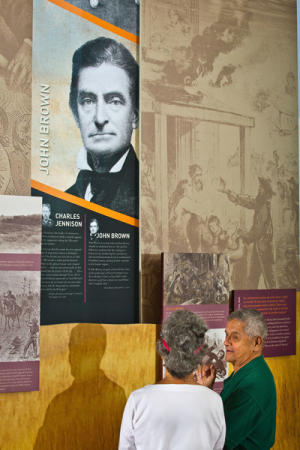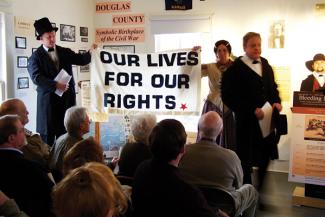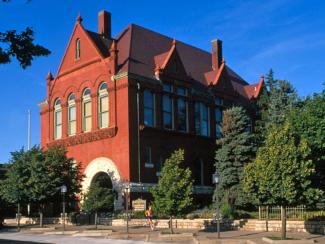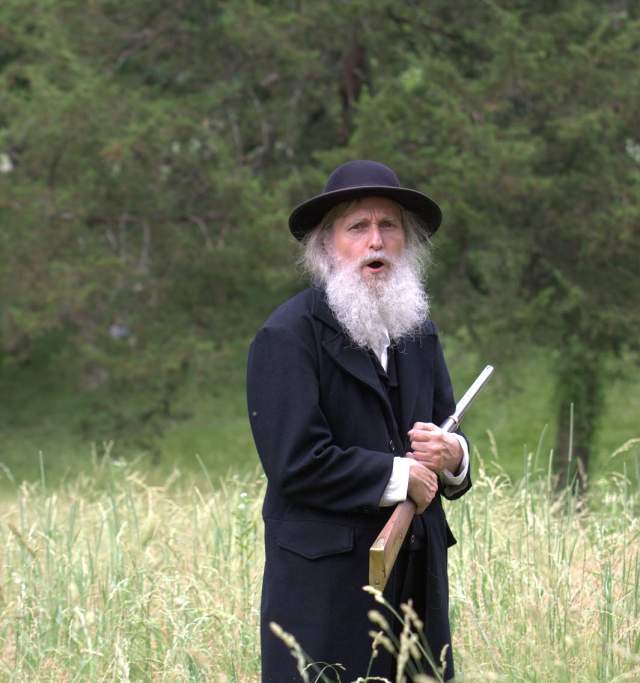The Struggle for Freedom
The story behind "Bleeding Kansas"
 Fiery John Brown, the white abolitionist, lived south of Lawrence. Believing that armed insurrection was the only way to overthrow the institution of slavery, he led small groups of volunteers during the Bleeding Kansas crisis. He and his supporters killed five pro-slavery southerners in what became known as the Pottawatomie Massacre in May 1856 in response to the raid on the “free soil” city of Lawrence. Later he was convicted of treason and hanged for his role in the raid on Harpers Ferry, Virginia. It’s not unusual to see depictions and modern takes on the famous John Steuart Curry mural of Brown, with a rifle in one hand and a Bible in the other, around Lawrence. Learn more about this period of our history at Freedom’s Frontier National Heritage Area display in the Carnegie Building, 9th and Vermont Streets or get more information at freedomsfrontier.org.
Fiery John Brown, the white abolitionist, lived south of Lawrence. Believing that armed insurrection was the only way to overthrow the institution of slavery, he led small groups of volunteers during the Bleeding Kansas crisis. He and his supporters killed five pro-slavery southerners in what became known as the Pottawatomie Massacre in May 1856 in response to the raid on the “free soil” city of Lawrence. Later he was convicted of treason and hanged for his role in the raid on Harpers Ferry, Virginia. It’s not unusual to see depictions and modern takes on the famous John Steuart Curry mural of Brown, with a rifle in one hand and a Bible in the other, around Lawrence. Learn more about this period of our history at Freedom’s Frontier National Heritage Area display in the Carnegie Building, 9th and Vermont Streets or get more information at freedomsfrontier.org.
 A large antislavery delegation marched into Lecompton in 1857 to protest the pro-slavery constitutional convention meeting. The nation waited to see if the constitution written here would lead Kansas to join the Union as a slave state. Discover more about the pro-slavery and free-state forces along with the territorial history of Kansas with a visit to Constitution Hall.
A large antislavery delegation marched into Lecompton in 1857 to protest the pro-slavery constitutional convention meeting. The nation waited to see if the constitution written here would lead Kansas to join the Union as a slave state. Discover more about the pro-slavery and free-state forces along with the territorial history of Kansas with a visit to Constitution Hall.
Civil War
When settlers first headed west to establish the city of Lawrence in 1854, they already had a strong sense of purpose. According to “popular sovereignty,” settlers could decide whether to allow slave holding in their territory. Abolitionists from the New England Emigrant Aid Company, who hoped to keep Kansas from entering the Union as a slave state, founded Lawrence.
 Lawrence’s role as the “Free State Capital” fueled many conflicts. Anti-slavery Jayhawkers from Kansas and pro-slavery Bushwhackers from Missouri battled incessantly, earning Kansas the nickname “Bleeding Kansas.” These Jayhawker-Bushwhacker conflicts over slavery set the stage for the Civil War.
Lawrence’s role as the “Free State Capital” fueled many conflicts. Anti-slavery Jayhawkers from Kansas and pro-slavery Bushwhackers from Missouri battled incessantly, earning Kansas the nickname “Bleeding Kansas.” These Jayhawker-Bushwhacker conflicts over slavery set the stage for the Civil War.
Visit Black Jack Battlefield near Baldwin City which commemorates what many say was one of the first battles of the Civil War that took place nearby in 1856.
Lawrence was committed to ending slavery, and acted as a major center for the Underground Railroad. Many prominent Lawrence citizens were “conductors,” secretly hiding runaway slaves until they could go north to freedom. One Lawrence man, Captain John E. Stewart, led many raids into Missouri to bring back fugitive slaves and helped them reach freedom. Visit the Wakarusa River Valley Heritage Museum near Clinton Lake to view the “Underground Railroad of Douglas County” exhibit.
 When Kansas entered the Union as a free state in 1861, conflict on the Kansas-Missouri border only intensified. On August 21, 1863, Lawrence suffered what some historians have called the greatest atrocity of the Civil War: Quantrill’s Raid.
When Kansas entered the Union as a free state in 1861, conflict on the Kansas-Missouri border only intensified. On August 21, 1863, Lawrence suffered what some historians have called the greatest atrocity of the Civil War: Quantrill’s Raid.
While Lawrence slept, pro-slavery guerrilla William Clarke Quantrill and approximately 400 men from Missouri prepared their attack. Shortly after five in the morning, they rode into the city. One witness recounted: “The attack was perfectly planned. Every man knew his place. They flowed into every street… The order was to burn every house and kill every man.” They killed only men and young boys; women and children were robbed but not harmed. The raiders killed approximately 200 men that day, leaving slews of widows and fatherless children. Fires devastated Lawrence’s commercial district; only a few buildings remained. As many as 185 homes were burned during the four-hour raid. For more information on the raid, go to www.kshs.org.
The resilient citizens of Lawrence buried the dead and banded together on the road to recovery. Within days, makeshift stores re-opened and rebuilding began. By the following spring, new stores, two newspapers and telegraph wires were established. The first bridge across the Kansas River at Lawrence was also finished. Only months later, the railroad came through. Lawrence had survived and would adopt the city motto: “From Ashes to Immortality.”
 The Watkins Museum of History’s core exhibit, which opened on the second floor in 2013, focuses on Douglas County’s free-state struggle and its Civil War history, including William Quantrill’s devastating 1863 raid on Lawrence. The exhibit explores how Lawrence rose from the ashes of that attack and, in more recent times, called on its early values to face the challenges of an enduring struggle for freedom, particularly during the civil rights era and anti-Vietnam War conflicts.
The Watkins Museum of History’s core exhibit, which opened on the second floor in 2013, focuses on Douglas County’s free-state struggle and its Civil War history, including William Quantrill’s devastating 1863 raid on Lawrence. The exhibit explores how Lawrence rose from the ashes of that attack and, in more recent times, called on its early values to face the challenges of an enduring struggle for freedom, particularly during the civil rights era and anti-Vietnam War conflicts.
Today’s Lawrence is very different from the frontier city raided by Quantrill, but much of its Civil War history remains. Many of the buildings constructed following the raid are still in use today, as are several of the buildings that aided the Underground Railroad. Let your imagination fill in the gaps as you relive that fateful August day in 1863 by following this itinerary:







